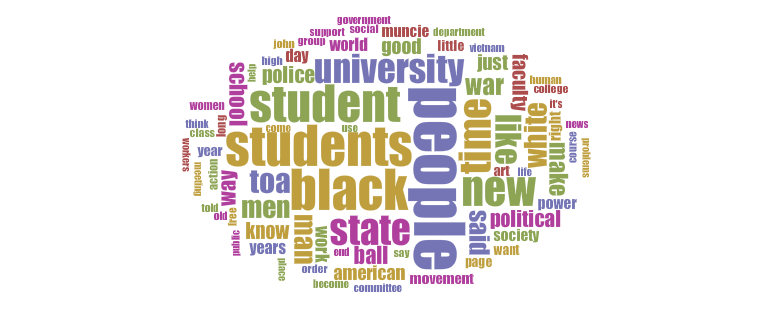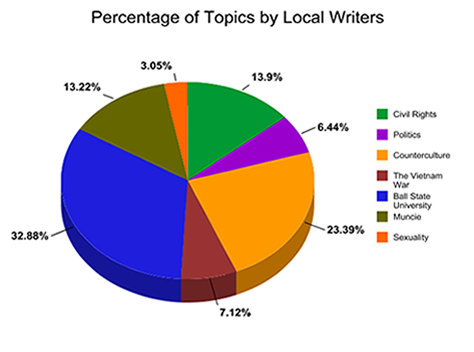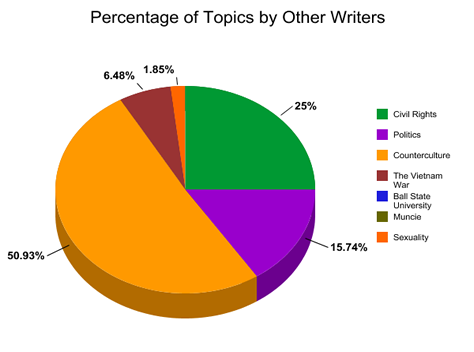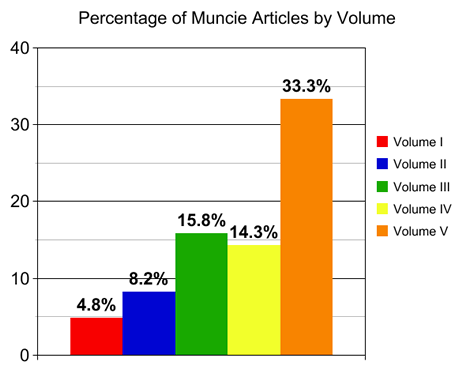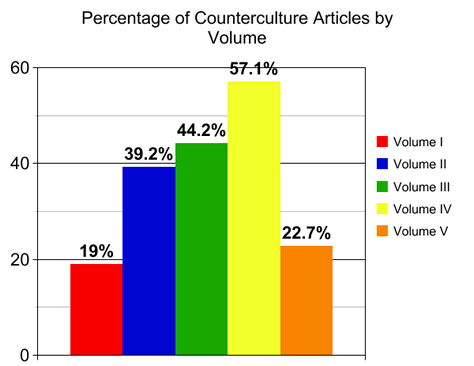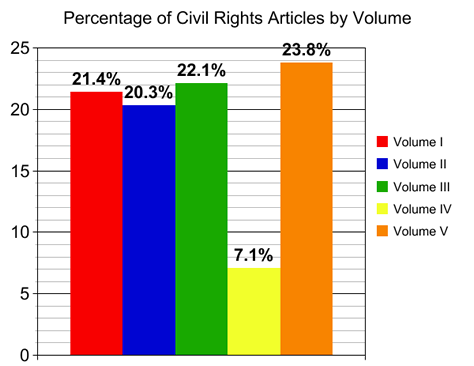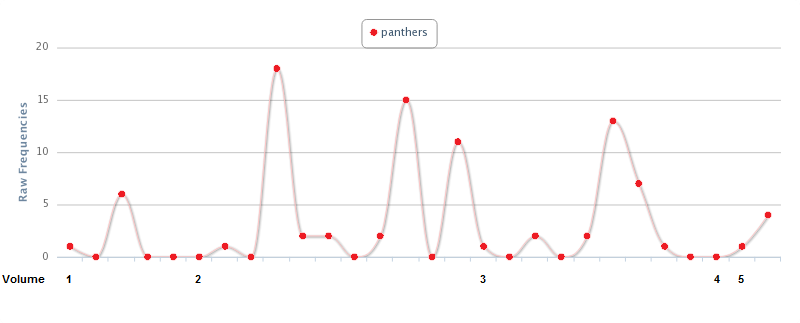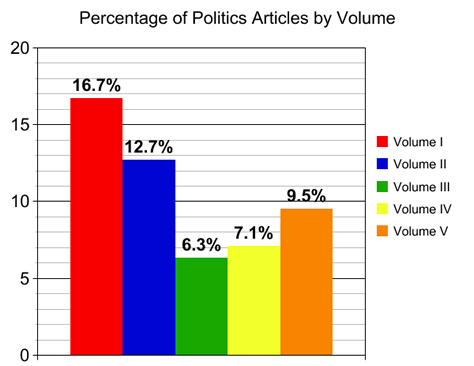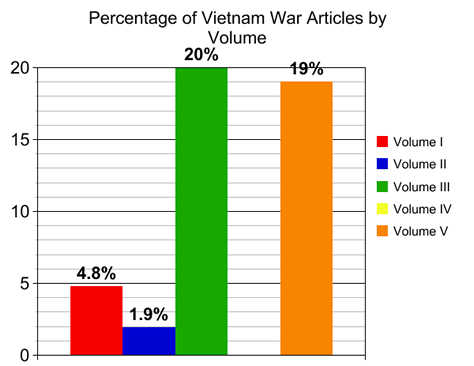Inside the paper:
While there have been several publications about Ball State University which mention The Only Alternative, none of them have provided an indepth discussion of the content. Tony Edmonds article, "The Only Alternative: Even Muncie Had An Underground Press" discusses the newspaper's position on the Vietnam War and compared it to that of Ball State and the Muncie community. While this article provides good insight into this aspect of the newspaper, it does not discuss other themes. In his history of Ball State, Edmonds and Bruce Geelhoed also mention the newspaper though they simply mention that this more liberal newspaper caused a commotion in the Muncie community. (Edmonds, The Only Alternative, 104-109; Edmonds and Geelhoed, 202) This section of the project attempts to add to the previous scholarship on TOA by analyzing the content of the newspaper in greater depth.
There are two studies on the Underground Press which influenced this analysis. The first article is "The Underground Press in America (1964-1968): Outlining an Alternative, the Envisioning of an Underground" by James Lewes. In this article, Lewes analyzes the editorials and "statements of purpose" of over 100 underground newspapers to see how these papers related to their audience and how this compared with the mainstream press. In this article, he found three key aspects of the Underground Press. After reading through TOA, it is clear that the aspects which Lewes found appear in TOA as well. The following section will analyze these aspects and compare them with the content of TOA.
The first aspect of the Underground Press that Lewes found is that "each and every underground newspaper was first and foremost a countercultural community newspaper." (Lewes, 381) While reading TOA, it quickly becomes apparent that it is a Muncie newspaper. The following graph illustrates how much of the newspaper was dedicated to Muncie or Ball State:
With 42% of the articles dedicated to local subjects, TOA is clearly a local newspaper. With most of the rest of the articles dedicated to the Counterculture, the Civil Rights Movement, and the Vietnam War, TOA is also clearly countercultural, placing it well within Lewes first aspect of the Underground Press.
The second aspect which Lewes found was the "underground press actively engaged in an, albeit one-sided open debate with the institutions of corporate mass media." (Lewes, 385) This second aspect is seen in the interplay between the Daily News and TOA, especially as TOA published several articles addressing the Daily News with no response. While the Daily News printed several editorials about TOA, they never addressed questions or comments toward the newspaper in such a way as to engage in any real conversation or discussion about the topics. Even in interviews with the writers of TOA, the conversations stuck to the topic of making the paper and the goals of the paper, not a discussion of any of the subjects or beliefs of the writers on certain topics. This aspect of the paper is discussed further here.
Finally, Lewes found that the Underground Press addressed the Counterculture and the Movement which the mainstream media had failed to discuss. As Lewes stated, "for underground press activists, not only were the needs of these communities ignored but these communites were in fact framed through, and grounded against, the claims of those in positions of authority." (Lewes, 389) Much of the content of TOA is dedicated not just to topics that were left out or ignored by the mainstream press, but specifically to speaking out against the positions of "authority" such as the Ball State administration, professors, or special speakers who visited campus. In addition to speaking against this authority, TOA recognized that it only existed because it represented this countercultural community, and their success or failure depended upon how they represented the needs of this community.
These three elements of the Underground Press seen by James Lewes all appear in the pages of The Only Alternative, suggesting that it fits right into this larger national phenomenon. The idea that TOA is representative of the Underground Press is further backed up when it is broken down into its different subjects. In Jack Levin and James L. Spates' article “Hippie Values: An Analysis of the Underground Press,” they broke down a cross section of the Underground Press into the different values which the newspapers present. They chose to examine values specifically because they believe that, "conflict between different values as an expression of the basic gap between the hippie and middle-class views of life. Values are the most general directives for action in society, in that they are the most generally shared ideas about the correct wat to behave. A challenge to the values of a social system is therefore regarded by the members of that system as a basic threat to the very raison d'etre of their social structure." (Levin and Spates, 60) Levin and Spates broke down the different types of values they found into three categories: expressive, instrumental, and other. At first I wanted to follow a similar approach in my anaysis of TOA, though this proved difficult as it meant reading through the entire run of the newspaper with enough detail to understand the "values" presented in each article. Levin and Spates were able to use students to help them choose passages at random from a wide cross section of the Underground Press. Without assistance and a larger body of work to choose from, I could not use this method effectively. Instead, the method used by Christina Blasingame, Dee Brown, and Lee S. Duemer in their study of The Catalyst is more helpful when studying just one newspaper. These authors broke down the different sections of The Catalyst into only three themes: The Vietnam War, Government and Politics, and Civil Rights and Race Relations. Using this basic idea, I broke down The Only Alternative into seven topcs. This allowed me to break down a fairly large amount of text into smaller categories for deeper analysis. With 28 full issues ranging from 12 to 35 pages, The Only Alternative covered many topics during its three year run. The following wordcloud represents a breakdown of the most commonly used words in the full run of the newspaper:
Just using this word cloud as a representation of the content of TOA, there are several subject which are suggested. The high useage of the words "black," "white," "students," and "war" suggest the themes of the Civil Rights Movement, an emphasis on students, and a focus on the Vietnam War. While this is interesting and a good starting point, it can only suggest important subjects within the newspaper. After reading the full run of the paper and preparing the metadata for the digital collection it became clear that many of these words did indeed suggest topics of importance. While there are dozens of subjects within TOA, these can be combined into the following seven general topics:
These graphs illustrates that The Only Alternative was a local newspaper first. With over40% of the articles dedicated to Ball State University and Muncie, Indiana, it is clear that local issues were at the forefront of the writers' minds. This percentage becomes even larger when the articles reprinted from LNS or other underground newspapers are removed. The following graphs compare the percentage of articles on each topic written by local authors and LNS authors:
The Categories:
Ball State University: These articles deal specifically with the University. Many deal with problems with the administration or with specific academic programs. Other articles deal with concerts, special speakers, and other events on campus. The following articles discuss the formation of the John Brown Society on campus and an all-campus to discuss issues with the administration and University polities:
Dave Kitts “John Brown Society Forms” The Only Alternative Vol. II No. 11 (May 13, 1969) pg. 9
Mark Sharfman "Mass Meeting" The Only Alternative Vol. IV No. 1 (November 1970), pg. 4
While articles on Ball State make up over 30% of the total number of articles in TOA, that does not mean that they were evenly distributed throughout the newspaper. The following graph illustrates how the percentage of Ball State articles changed with each issue:
The noticeable dip in Volumes III and IV can only be explained by the departure of William Harriff from his position of editor at the end of Volume II. With Harriff's high involvement in Ball State student politics and his critical view of the Administration, TOA held a heavily critical view of the Administration in Volumes I and II. During this time, TOA had a continuing series called "University Problems." This column featured a different department or different aspect of a department each week. The plan was to go through most of the different schools and critique them, an ambitious goal. The column only ran for five issues however and only discussed the Political Science and English Departments. Most of the Ball State articles in Volume III discuss the Vietnam War, particularly the Moratorium which came in October 1969. Volume IV only consisted of 1 issue and therefore only had 2 articles on Ball State, while the 2 issues of Volume V have only 6. As a periodical published almost solely by Ball State students, it is not a surprise that this subject matter comprised 30% of the newspaper.
While these articles vary in topics and are written by different authors, there are a few words and subjects which are important through the entire run of the newspaper. These words are given in context below using Voyant Tools "Words in Context" feature.
President Pruis - John Pruis was president of Ball State University from 1968 to 1978. As he was president during the entire run of TOA, he in particular drew the ire of the writers. This is seen in several of the passages below:
Muncie: These articles deal with the Muncie community. Many of them focus on the Muncie Police department, racism in Muncie, and other problems with housing and the local school system. The following articles discuss problems with the Muncie Police Department and the building of a new school in Muncie:
Anonymous "Pigs in the Street” The Only Alternative Vol. 1 No. 4 (December 1, 1968), pg. 3
Paul Rozycki “Rumbles from the Bethel Pike Fault” The Only Alternative Vol. II No. 11 (May 13, 1969), pg. 8-9
As with the articles on Ball State, those on Muncie vary from issue to issue. While they make up 12% of the entire newspaper, they began as only a small percentage of the first volume. While the exact reason is unknown, the percentage of articles on Muncie doubled as the percentage of articles on Ball State were cut almost in half. By Volume V, over 30% of the articles dealt with Muncie. Most of these articles focused on the poor housing conditions. One reason for this is that Angelo Franceschina, who wrote several articles in Volume V, was particularly intersted in community development. He seems to have had a strong influence over the last two issues as they have a much larger number of articles dealing with problems in the Muncie community.
One of the most common aspects of articles dealing with Muncie is the use of the term "pig" or "pigs" to refer to the Muncie Police Department. As is discussed further here, while the staff of TOA did not face the same level of resistence from the police and other government agencies as some underground newspapers did, they still had a tense relationship with law enforcement. This came mostly because many in the communitybelieved that TOA was explicit or pornographic. There were also issues concerning drug useage, though TOA were not as openly a proponent of drug useage as many other undergrounds.
Counterculture: These articles deal with the New Left, drug culture, and reviews of music, movies, and books. The following articles discuss the works of Allen Ginsberg and difficulties finding marijuana in 1969:
Steven Stillwell “Ginsberg on the Wabash” The Only Alternative Vol. II No. 11 (May 13, 1969), pg. 25-27
Sunking “The Legendary Dope Famine of ‘69” The Only Alternative Vol. III No. 6 (December 12, 1969), pg. 12
In addition to the largest portion of the newspaper being dedicated to the different aspects of the Counterculture, TOA featured an eight page addition to the paper entitled, "The Whiteriver Review." This portion of the newspaper featured reviews of different media including books, films, and music. It also featured poetry and an occassional fiction story. While the rest of the newspaper dealt with news from campus and around the country, this section allowed the reader to stay up on the culture of the Sixties, rather than just the unrest and political issues.
The next chart shows the use of the words "marijuana" and "dope" which are the most commonly used words refering to drugs in TOA. The numbers represent the actual number of occurences for the terms. With the exception of Volume III No. 6, these terms do not appear very often in the newspaper. While TOA was certainly in favor of the legalization of marijuana, they did not dedicated much of the newspaper to this subject. The articles that did advocate for legalization discussed Le Mar (short for Legalize Marijuana), a campus organization which formed to, as its name suggests, advocate the legalization of marijuana. While there was evidently a split in the newspaper staff over the use of drugs, at least one member was involved with the Aquarius House Crisis Hotline, a call center for those who needed help with adiction and other affects of drug use.
One of the main functions of the Underground Press was the dessemination of the Counterculture. Without these newspapers and other underground publications circulating among the youths, it is unlikely that the Counterculture would have spread to the same extent. TOA certainly played a part in that for the youths of Muncie and the surrounding areas.
Civil Rights: These articles deal with the Black Movement, the Black Panthers, the rights of prisoners, and other Civil Rights issues. The Civil Rights Movement is one of the most frequent topics in the newspaper. The newspaper features two issues dedicated to the Black Movement. (Vol. I No. 3 and a later issue dedicated to the memory of Malcolm X) The following articles include an article discussing the need for whites and blacks to work together in the Civil Rights Movement and an article directed at African-American students at Ball State:
David R. Auble “An Open Letter to the Black Brothers and Sisters” The Only Alternative Vol. I No. 1 (September 1968), pg. 10, 12
Larry Whitney “A Message to Apathetic Black Students at B.S.U.” The Only Alternative Vol. I No. 3 (November 1968), pg. 4
The Civil Rights Movement was obviously a focal point of TOA. Only one volume had fewer than 20% of the articles dedicated to this subject. TOA was fully supportive of groups like the Black Panthers and Beaver 55. While many of the articles on these subjects were from the Liberation News Service, there was no editorial which suggested anything other than approval. In fact, Dave Kitts, one of the important contributers to TOA, worked with the local Black Panthers to put together a funeral service for Fred Hampton, one of their leaders who was killed in a suspicious police shootout. The following graph charts the use of the word "Panthers" across the 28 issues of TOA. It shows four significant spikes in the discussion of the Black Panthers. The second spike came just after the "Panther 21" incident in which 21 Panthers were jailed as a result of a bombing conspiracy. The third spike came in May 1969 when there was several instances of Black Panthers being incarcerated or killed. The fourth spike came just after the death of Fred Hampton and around the time that David Hilliard, another Panther leader, began advocating more violent reactions from the Black Panthers.
While a few of the Civil Rights articles dealt with these more radical groups, most of the articles pushed the idea of awareness of the problems for both white and black students, especially at Ball State. Several articles also bring attention to unfair and racist events in Muncie such as the building of a new school in an area with a low percentage of African-American students while the school with a high percentage of African-American students was at nearly double capacity. TOA dedicated two issues especially to the Civil Rights Movement as it was clearly one of the most important issues of the Sixties.
Politics: These articles deal with specific political events such as elections or laws. The following examples include an article reviewing presidential candidates and an advertisement about a political conference in Indiana:
John Q. Analyass “National Report: 'A Giant Pig Pen' or, How Not to Play the Game of the Lesser of Two (Three) Evils." The Only Alternative Vol. I No. 1 (September 1968), pg. 2, 7
Sue Harriff “Indiana Conference on New Political Goals” The Only Alternative Vol. II No. 1 (January 10, 1969), pg. 13
This section represents a rather small portion of the newspaper. Volume I Issues I and II dealt specifically with the 1968 presidential election as it they came out in September and October 1968, just months before the election. TOA offered a critique of the candidates and attempted to offer voting advice for the reader. Other "Politics" articles deal with the formation of different political societies on campus and political conferences.
The Vietnam War: These articles deal with anti-war protests and other issues surrounding the Vietnam war. The following examples include an article about the experiences of a draft dodger and the Vietnam War Moratorium in Muncie:
John Bagely “Resist! Non-Cooperator Ball Stater” The Only Alternative Vol. I No. 4 December 01, 1968
Anonymous “Bringin’ the War to Muncie” The Only Alternative Vol. III No. 2 (October 3, 1969), pg. 1-2
Sexuality: These articles deal with sexuality and the sexual revolution of the 1960s. The following articles deal with life as a homosexual on the Ball State campus and the difficulties of living in a society which preaches abstinence long after reaching sexual maturity:
Johannes Expatriatus “Sex and a Single Observation” The Only Alternative Vol. II No. 2 (January 28, 1968), pg. 5
W.T. Quick “Under the Underground the Bitter Fruit: A Survey of Homosexuality on Campus” The Only Alternative Vol. II No. 3 (February 7, 1969), pg. 4-6
A further analysis of sexuality in The Only Alternative is presented here.

